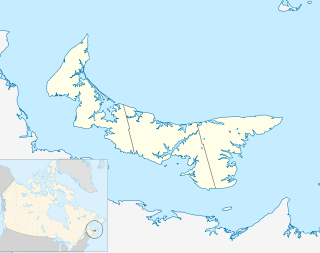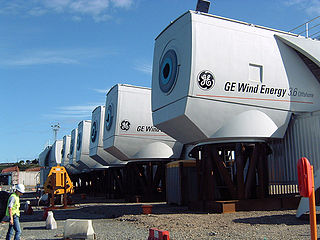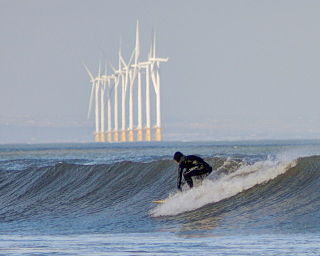
A wind farm or wind park, also called a wind power station or wind power plant, is a group of wind turbines in the same location used to produce electricity. Wind farms vary in size from a small number of turbines to several hundred wind turbines covering an extensive area. Wind farms can be either onshore or offshore.

Guthega Power Station is located in the Snowy Mountains region of New South Wales, Australia. The power station's purpose is for the generation of electricity. It is the first to be completed and smallest of the initial seven hydroelectric power stations that comprise the Snowy Mountains Scheme, a vast hydroelectricity and irrigation complex constructed in south-east Australia between 1949 and 1974 and now run by Snowy Hydro.
Crookwell Wind Farm, located at Crookwell west of Goulburn, New South Wales, consists of eight 600 kW wind turbines giving a total capacity of 4.8 MW. It was the first grid-connected wind farm in Australia when built by Pacific Power in 1998. It is now owned by Tilt Renewables.

The Blayney wind farm is a wind power station at Lake Carcoar, south of Blayney, New South Wales, Australia. It was acquired by Trustpower in 2014, and is now owned by Tilt Renewables. Blayney has fifteen wind turbines, with a total nameplate capacity of 9.9 MW of electricity.

The United Kingdom is one of the best locations for wind power in the world and is considered to be the best in Europe. By the end of May 2021, the UK had 10,961 wind turbines with a total installed capacity of over 24.1 gigawatts: 13.7 gigawatts of onshore capacity and 10.4 gigawatts of offshore capacity, the sixth largest capacity of any country in 2019. Wind power contributed 24.8% of UK electricity supplied in 2020, having surpassed coal in 2016 and nuclear in 2018. It is the largest source of renewable electricity in the UK. The UK Government has committed to a major expansion of offshore capacity by 2030.

Windy Hill Wind Farm is a wind power station near Ravenshoe on the Atherton Tableland, Queensland, Australia. It has 20 wind turbines with a generating capacity of 12 MW of electricity, providing enough power for about 3,500 homes. The cost of the project was A$20 million. It was the second wind farm to be constructed in Queensland after the 0.45Mw station on Thursday Island (1997).

North Cape is a cape at the northwesternmost extremity of Prince Edward Island, Canada. It is located within the community of Seacow Pond.

Arklow Bank Wind Park is a 25 megawatt offshore wind farm generating electrical power for the Wicklow region in Ireland. It is the first offshore wind farm in Ireland, and the world's first erection of wind turbines rated over 3 MW. It is located on the Arklow Bank, a shallow water sandbank in the Irish Sea, around 10 kilometers (6.2 mi) off the coast of Arklow with an area of 27 by 2.5 kilometres.

Wind power is one of the main renewable energy sources in Australia and contributed 10% of electricity supplied in 2020, with 37.5% of total renewable energy supply. Australia has excellent conditions for harvesting wind power with abundant wind resources located close to population centres in the southern parts of the country and on the slopes of the Great Dividing Range in the east.

Wind power became a significant energy source within South Australia over the first two decades of the 21st century. As of 2015, there was an installed capacity of 1,475 MW, which accounts for 34% of electricity production in the state. This represents 35% of Australia's installed wind power capacity.
The Snowtown wind farms are located on the Barunga and Hummocks ranges west of Snowtown in the Mid North of South Australia, around 150 kilometres (93 mi) north of the state capital, Adelaide. They were developed by Trustpower and owned by Tilt Renewables, which demerged from Trustpower in 2016. The first stage of 47 turbines was completed in 2008 and Stage 2 of 90 turbines became operational in 2014. Stage 2 was sold by Tilt Renewables to Palisade Investment Partners in December 2019.
Coopers Gap Wind Farm is a 453 megawatt wind farm in the Western Downs and South Burnett regions of Queensland, Australia. It is located approximately 175 km north-west of the state capital Brisbane, and 50 kilometres south-west of Kingaroy and 65 km north of Dalby.

The Lincs Wind Farm is a 270 MW offshore wind farm 8 kilometres (5.0 mi) off Skegness on the east coast of England. The total cost of the project is estimated at £1 billion including electrical transmission links. The farm was completed in 2013. It is adjacent to the smaller Lynn and Inner Dowsing Wind Farm.

Teesside Wind Farm, or alternatively referred to as Redcar Wind Farm, is a 27 turbine 62 MW capacity offshore wind farm constructed just to the east of the mouth of the River Tees and 1.5 km north of Redcar off the North Yorkshire coast, in the North Sea, England.
REG WindPower is a renewable energy company, in the United Kingdom.

Wind power in Rhode Island is in the early stages of development. There are several small scale wind turbine projects in the state. As of December 2013 there were 11 turbines at 10 sites in the state. In 2014, Rhode Island had 9 MW of installed wind power capacity, which quickly rose to 75 MW in 2019.
The Taralga Wind Farm is a wind farm located near Taralga, New South Wales.
Sapphire Wind Farm is a wind farm in the Australian state of New South Wales. When it was built in 2018, it was the largest wind farm in New South Wales. It is in the New England region of northern New South Wales, 28 kilometres (17 mi) east of Inverell and 18 kilometres (11 mi) west of Glen Innes. The farm covers approximately 8921 hectares of cleared grazing land, and has an elevation of about 750 to 1100m. It is north of the Gwydir Highway. The White Rock and Glen Innes Wind Farms are south of the highway closer to Glen Innes. It is intended to be colocated with a 200 MW solar farm. The wind farm contains 75 Vestas V126 turbines, each of which can generate 3.6 MW of electricity. They have a 137-metre hub height and 126-metre rotor diameter. The project is approved to build up to 109 wind turbines.
Taiba N'Diaye Wind Power Station,, is a 158.7 MW (212,800 hp) wind power plant in Senegal. When completed, as expected in 2020, the power station will be the largest wind power station in West Africa.













